Markets and Regulation Master
1/129
There's no tags or description
Looks like no tags are added yet.
Name | Mastery | Learn | Test | Matching | Spaced |
|---|
No study sessions yet.
130 Terms
Core Principles of Economics
Efficiency: benefits > costs
Pareto efficiency
Kaldor-Hicks efficiency
Should the law aim to be efficient? —> Posner’s, Friedman, Cooter and Ulen
Welfare: Utility = satisfying desires
Transaction: transfer of property rights
Pareto efficiency
an allocation is efficient when one person is made better off without making someone else worse off (win-win)
Kaldor-Hicks efficiency
an allocation can be efficient even if someone loses, as long as the winner(s) could compensate the loser(s) (potential win-win)
Should the law aim to be efficient?
Posner’s ex-ante consent argument: before knowing our place in society, we would all choose efficient rules
Friedman’s argument: efficiency matters to most people; legal systems often designed to generate efficient outcomes
Cooter and Ulen: efficiency is crucial for the legal system, but society also addresses other goals
Market failure
imperfect competition
external effects
public goods
information asymmetries
Regulatory failure
incomplete information
lobbying
short time horizon
budget maximization
corruption
perfect competition
market = demand and supply
characteristics:
many suppliers and consumers
homogeneous goods
no transaction costs (perfectly transparant; property rights defined; free entry and exit)
MR = p
Price elasticity
Price elasticity of demand tells you how much the quantity demanded of a good changes when its price changes.

consumer surplus
difference between price that consumers are willing to pay and equilibrium price
producer surplus
difference between equilibrium price and price that entrepreneurs want to receive
monopoly
In a perfectly competitive market the price is given, the producer can only control the quantity provided and MR = P. Profit is maximised where MR=MC.
Producers aim to maximize profits: profits are (always) maximized where MR=MC.
The MR line is downward sloping in a monopolistic market, because the monopolist can set the market price. TR highest when MR = 0
welfare costs of monopoly
rent-seeking: welfare costs of maintaining monopoly
x-inefficiency: relatively weak incentive to control costs
dynamic inefficiency: relatively weak incentive to innovate
oligopoly
few suppliers (homogeneous oligopoly / heterogeneous)
no unequivocal oligopoly theory
behavior: preferably no price competition, firms coordinating behavior via cartel/merger
Cartel
oligopolists acting together as monopolist
economically unstable
free-riding: produce more than illegally agreed
collective action problem: cartel only enforceable in a small group of firms
entry: cartel’s excess profits attract new competitors
Monopolistic competition
many suppliers but heterogeneity of the product creates a monopolistic situation
not just price but also other product characteristics matter
every product has its own submarket where producer can behave like a monopolist
welfare increasing compared to monopoly
Deadweight loss
the loss of total economic efficiency that occurs when the equilibrium in a market is distorted, usually by things like taxes, subsidies, price controls, or monopolies.
Analyze imperfect competition
Imperfect competition refers to market structures where the assumptions of perfect competition—many buyers and sellers, identical products, and full information—do not hold. In these markets, firms have some control over prices, leading to higher prices, lower output, and reduced efficiency compared to perfect competition.
Types include:
Monopoly: one firm dominates, setting prices high.
Oligopoly: a few firms may collude or act strategically.
Monopolistic competition: many firms offer similar but differentiated products, leading to brand-based price differences.
The result is often deadweight loss, less consumer surplus, and potential for market abuse unless regulated.
types of public goods as market failure
non-exclusive: no individual can be excluded from its use
non-rivalrous: use by one individual does not reduce the availability to others
Tragedy of the commons
tendency for a resource that has no price to be used until its marginal benefit falls to zero
quasi-public goods
private goods partly financed by the government
negative externalities vs. positive externalities
Damage to others without compensation (noise)*
VS
Others profit without paying (dike).
external effects definition
(1) advantages or disadvantages associated with the consumption and/or production of a good
(2) that fall on or accrue to other people than the direct users of that good
(3) without financial compensation.
Coase theorem conditions
conditions:
no/low transaction costs;
no public good;
parties have sufficient means to compensate;
clear property rights
how to internalize externalities when transaction costs are positive
taxation
direct regulation
liability law
asymmetric information
seller has more/better information than potential buyers
reduces the average quality of goods offered for sale
potential solutions:
parties can communicate knowledge truthfully
regulation & self-regulation

What is the effect of the minimum price Pmin on the quantity supplied and the quantity demanded?
Effect minimum (or: floor) price Pmin:
Supply = q(K); Demand = q(R)
Oversupply q(RK) = ‘milk lake’!
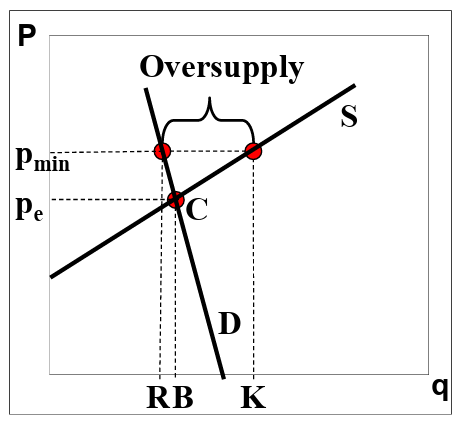

What is the effect of the minimum price on milk producers’ revenues?
Effect minimum price on producers’ revenues:
in equilibrium revenue = Pe x q(B)
Now higher revenue: Pmin x q(R)
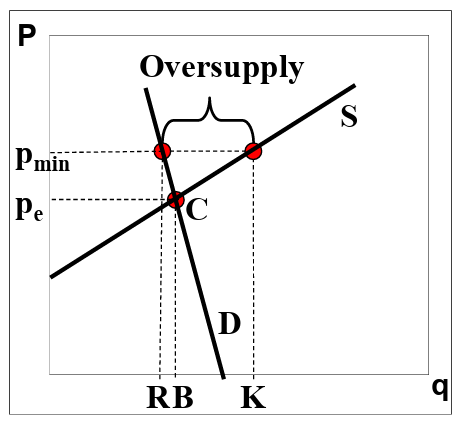

Do milk consumers gain or loose from a minimum price?
Consumer pays twice:
higher price for milk (smaller consumer surplus)
extra tax money needed to buy up ‘milk lake’

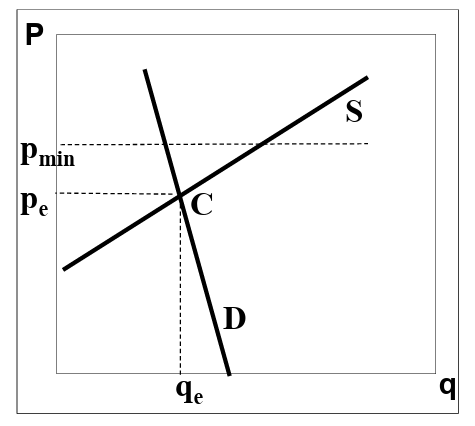
Would a minimum price for milk be efficient or inefficient for society at large?
At Pmin demand is qmin
consumer surplus is EFPmin
Producer surplus is HKFPmin
Welfare loss is KCF
hence: (Pareto-) inefficient
minimum price for milk could be seen as fair (for producer) or as unfair (for consumer); but: consumer pays twice
minimum price for milk is inefficient due to welfare loss for society at large
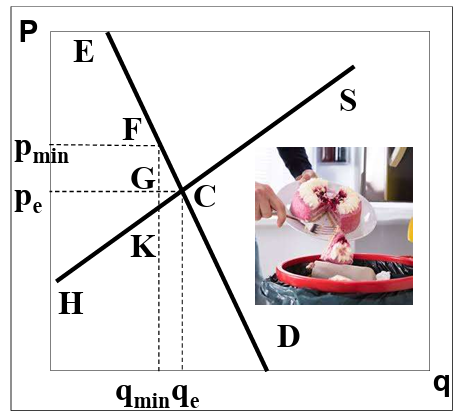

Nuisance case: project developer vs local residents
Project developer: higher apartment building = higher profit
Local residents: higher apartment building = more damage (in the form of loss of living enjoyment)
See the table: how many floors should the judge allow to ensure an efficient allocation of rights?
Efficient allocation is realized with 5 floors where MR=MC, namely where marginal profit is equal to or at least still higher than marginal damage (or: where the difference between total profit and total damage is the biggest)
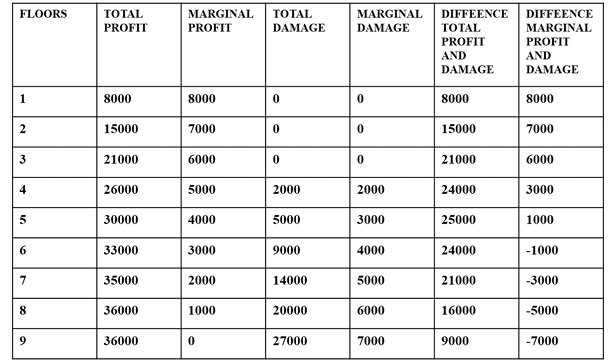
Nuisance case: project developer vs local residents
Project developer: higher apartment building = higher profit
Local residents: higher apartment building = more damage (in the form of loss of living enjoyment)
Suppose the judge allows 3 floors: will he project developer comply or build more floors in case of a liability protection of local residents?
When the judge allows 3 floors, the project developer will still build 5 floors, because he can increase his profit by building 2 extra floors even though he has to compensate the damage for the local residents
Emissions trading is a market-based instrument to achieve an emission reduction target cost-effectively by allowing companies to buy and sell emission allowances. In the EU, companies are legally obliged to cover their yearly emissions with (an equal amount of) CO 2 16 emission allowances.
Prior to 2013, electricity producers received their tradable emission allowances for free, but they passed through the market value of those rights in the electricity price.
Consumers then accused producers of making windfall profits and argued in favour of more competition in the oligopolistic electricity market to stop or at least reduce those windfall profits.
Will more competition in the electricity market reduce or even make an end to those windfall profits from free allowances?
›💰 Opportunity costs of free emission allowances are passed on to consumers no matter what the market structure is.
⚡ More competition = bigger price increase = more cost passed to consumers
→ Called “windfall profits” by policymakers.✅ In competitive markets, price = cost (P = MC), so this is normal.
😃 More competition = lower electricity prices for consumers overall.
📈 Passing on opportunity costs is economically correct, even if it causes windfall profits.
🛑 Want to avoid windfall profits? → Auction the emission allowances instead of giving them for free (as done after 2013).
🌍 Higher electricity prices help society by putting a price on CO₂, which helps fight climate change.
Property rights
A bundle of rights that include:
right of use
right to enjoyment
right of exclusion
right of disposition
and right to split the bundle
exclusion and disposition make exchange possible
How do laws influence transaction costs
They may reduce or increase transaction costs depending on their design
default rules: govern situations not regulated by contract parties
binding power of agreements: reduces monitoring costs for parties
good faith: limits strategic behavior when interpreting contracts
Coase theorem
Allocation of property rights does not matter for efficiency (unless transaction costs)
Social costs = external costs
by negotiating over rights, externalities can be internalized so that social costs cannot exist in the micro-economic model
extra assumption necessary for social cost: the existence of transaction costs
For efficiency it doesn’t matter to whom the rights are allocated because without transaction costs parties can negotiate to internalize the externality
Validity of Coase Theorem is limited due to transaction costs - in case of transaction costs allocation does matter for efficiency
transaction costs
the time, money and paperwork it takes to make deals
Calabresi and Melamed
property rule A = A prohibits damage by B;
liability rule A = B may cause damage, provided A is compensated;
property rule B = B may cause damage (unless transfer of entitlement to A);
liability rule B = A prohibits damage by B, provided B is compensated.
Sturges versus Bridgman: Nuisance case 1879: doctor Sturges moved next door to baker (confectioner) Bridgman
Doctor: ‘The noise disturbs me: it “causes great discomfort and annoyance”’
Baker: ‘I was here first: “during the last sixty years [we] carried on the business”’
› Court ruling: Doctor has right to work in silence (nuisance weighs more than doctor coming to the nuisance) › Coase: more efficient would have been to negotiate (or mediate) and allow for some noise
› Conclusion Coase: doctor right or baker right does not matter for efficiency
Both in option 1 and in option 2 parties choose the intersection of both curves where P = MC
Additional conclusion: Choice is not so much between noise or no noise, but between a lot of noise or little noise

Efficient breach of contract
End the agreement, breach the contract, if this provides an advantage to the breaker, provided he fully compensates the other party for damage
magnitude of compensation: such that the counterparty remains at least equal in welfare
breaker then internalizes full costs of breach of contract
only breach of contract if the benefit of non-compliance is greater than the welfare loss of the counterparty to be compensated: breach of contract is then Pareto efficient
Under efficient breach of contract, there is a choice between property rule or liability rule protection (Calabresi & Melamed)
Nuisance case: factory smoke vs local residents
✅ Total surplus is higher when smoke is emitted:
With smoke: €600
Without smoke: €580
📈 Niemeyer gains €40 more by emitting smoke:
From €160 → €200
📉 Lefier loses only €20 from allowing smoke:
From €420 → €400
⚖ Net gain to society:
Gain (€40) is greater than loss (€20)
💬 Lefier has the right to allow or block the smoke
🤝 Niemeyer can compensate Lefier (e.g., €30):
Lefier's loss (€20) is covered + €10 bonus
Niemeyer still gains €10 (after paying €30)
🔁 Result: Smoke is emitted, but the harm is internalized through negotiation → efficient and fair outcome

The bargain theory
principle: Promise is enforceable if part of a bargain, otherwise it is not
elements: offer, acceptance, and consideration (what promisee gives to induce the promise (reciprocal inducement)
the focus is on the presence of consideration, not adequacy
Economic critiques of the bargain theory
Underinclusiveness:
Fails to enforce promises that both parties want enforceable but lack consideration.
Frustrates potentially beneficial exchanges.
Bargain theory can be dogmatic (rigid rules) vs. responsive (serves parties' desires).
Examples: Firm Offers, Charitable Pledges.
Modern law uses doctrines like Promissory Estoppel to address this.
Overinclusiveness:
Mandates enforcement of any bargain, even if unfair, deceptive, or exploitative.
Ignores issues like fraud, duress, unequal bargaining power.
Example revisited: The Grasshopper Killer- Strict bargain theory enforces, but modern law voids for fraud.
Economic analysis explains why doctrines like Fraud and Unconscionability exist (correcting market failures).
The paradox of commitment
refers to a situation where being able to commit less (or being more flexible) actually leads to a worse outcome, while committing more strictly—even if it limits your options—can lead to a better result.
The paradox of limiting options
Purposes of contract law
facilitate efficient trade where trust and commitment are needed
to incentivize efficient level of performance and breach
to minimize transaction costs of negotiating contracts by supplying efficient default rules
Expectation damages
Puts promisee where they’d be if the contract was performed (“benefit of bargain”)
incentivizes efficient performance (perform only if cost < value)
Goal: put the victim in the position they would have been in had the contract been performed
Baseline: the state of the world with performance
Economic aim: make the victim indifferent between performance and breach + damages
Why? forces the breacher to internalize the victim’s full expected gain
Overreliance
when the promisee (the person relying on a contract) invests more in reliance on the contract being fulfilled than is economically reasonable, because they expect to be fully compensated if the contract is breached.
How do you mitigate overreliance
Hadley v. Baxendale:
problem: high damages (insuring reliance) can lead to promisee overreliance
economic solution: limit compensation for unforeseeable reliance. Promisee bears costs of unusual, undisclosesd reliance
legal doctrine: foreseeability rules
damages limited to losses foreseeable to the breaching party at contract formation
economic effect: caps damages, making promisee bear the cost of unforeseeable reliance. Incentivizes promisee to disclose unusual reliance to the promisor
Default rules
Real-world contracts are incomplete and have gaps due to the transaction costs of making a comprehensive contract - these help fill the gaps and provides efficient rules that parties would have agreed to in order to save transaction costs (majoritarian defaults)
Mandatory rules
sometimes courts override explicit contract terms
economic justification: correcting market failures or protecting third parties/public interest
examples:
lack of rationality: incompetence, duress, necessity
asymmetric information: fraud, duty to disclose, mutual mistake
monopoly power: unconcionability
externalities: public policy violations
Cooperation beyond formal enforcement
relational contracts: long-term relationships where trust, reputation, and informal norms are key
repeated interactions: enable informal enforcement
effective for ongoing relationships, smaller stakes per interaction
the endgame problem: informal methods weaken when relationship ends
formal contracts complements informal methods, crucial at start/end
Types of remedies
court-imposed: damages and specific performance
party-designed: liquidated damages
Incentives
Influence decisions before and during contract life:
contract formation
Investment in performance
reliance on promises
breach or performance
Reliance Damages
Restoring the pre-contract position
goal: put the victim in the position they would have been in had the contract never been made
baseline: the state of the world without any contract
key idea: compensate for losses incurred because the victim relied on the promise = > Protects against wasted investments
economic aim: make the victim indifferent between no contract and breach + damages
Opportunity cost damages
goal: put the victim in the position they would have been in had they signed the best alternative contract
baseline: the value of the foregone opportunity
idea: compensate for the lost opportunity of making a better deal elsewhere
Compare Damage Measures
Typical relationship:
expectation damages > opportunity cost damages > reliance damages
Why?
you choose the most valuable contract available
the contract is expected to be more valuable than no contract
expectation protects the full value of your chosen contract
opportunity-cost protects the value of your next-best option
reliance only protects against losses from changing position
Subjective value
Hawkins V. McGee (The Hairy Hand case)
facts: doctor promised a perfect hand, delivered a much worse hair hand
problem: how to measure damages when the value is subjective and has no market price?
Highlights: difficulty applying standard damages when subjective value differs from market value
Specific performance
Court orders the promised performance instead of damages
typically used when:
goods are unique
damages are hard to calculate
close substitutes don’t exist
economic considerations
avoids difficulty of valuing subjective loss
gives promisee strong bargaining power
may lead to inefficient performance if renegotiation fails
Liquidated damages
a fixed amount of money that two parties agree in advance will be paid if one of them breaks the contract.
It’s used to avoid arguing later about how much harm was caused — the amount is set upfront to make things clear and simple if something goes wrong.
💡 Think of it like a pre-agreed “penalty” for not keeping your promise.
Do different remedies lead to efficient breach?
coase theorem: costless bargaining = efficient outcomes; legal rules only affect distribution
Real world: transaction costs exist
Remedy can affect efficiency.
Expectation Damages: Facilitates efficient breach. Promisor chooses cheaper option (perform vs. breach + pay damages), internalizing victim's loss.
Specific Performance: Gives victim strong right. Can lead to inefficient outcomes if bargaining fails due to high transaction costs when performance is costly. (Advantage: Avoids court valuation).
Investment in performance and reliance
remedies influence investments made before breach
promisor’s investment in performance:
💼 Money, time, or effort a party puts in to carry out their part of a contract (e.g. producing goods, preparing services).
👉 It's about doing what you promised.
promisee’s reliance on promise:
🔧 Resources a party spends because they trust the other side will perform (e.g. building a store expecting delivery of goods).
👉 It's about preparing based on the other party's promise.
economic goal: incentivize efficient levels of both
Anticipatory breach
Promisor repudiates contract before performance is due
example: seller announces one month before delivery that van won’t be delivered
issues:
when should damages be calculated
should promisee be compensated for post-repudiation reliance
how does timing affect efficient breach
What is a tort
a civil wrong that causes harm to a person or property
Tortious liability
arises from the breach of a duty primarily fixed by law that is towards persons generally and is redressable by an action for unliquidated damages
types of torts
intentional torts: deliberate acts that cause harm
tort of negligence: harm caused by failure to exercise reasonable care
strict liability torts: liability imposed regardless of fault
Essential elements of a tort claim
breach of duty
harm
causation
Strict liability: only harm and causation required
negligence: all three elements
Types of costs
cost of precaution: expenses incurred to prevent accidents
cost of expected harm: the anticipated monetary value of injuries, property damage, and other losses if an accident occurs
Expected social cost
the sum of the cost of precaution and the cost of expected harm
Minimizing social costs
Key elements:
x: Level (amount) of precaution taken to prevent accidents.
w: the cost of each “unit” of precaution
p(x): Probability of an accident occurring, given precaution x
A: Monetary value of harm caused by an accident (if it occurs).
Expected costs
Expected Cost of Accidents: p(x)A
Cost of Precaution: wx
Total Social Cost: p(x)A + wx
Social cost of accidents
Precaution Costs (wx) increase with care
Expected Harm (p(x)A) decreases with care
Total Social Cost (SC = wx + p(x)A)
Efficient Level of Precaution (x*)
Minimizes total expected social costs
Marginal cost = marginal benefit
w=−p′(x*)A
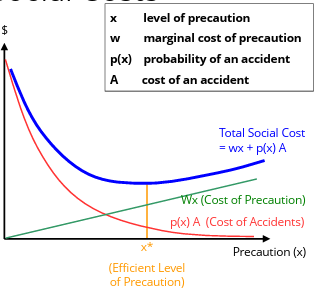
For efficiency, do post-accident events matter?
NO
compensation is just a wealth transfer:
it doesn’t change the total social cost - accident still destroys $1,000 in value and combined payoffs is always -$1,000
Implications:
focus on prevention, not redistribution
liability rules matter for incentives, not post-accident fairness
efficiency requires minimizing total costs, not balancing them
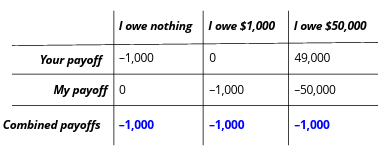
Incentives for precaution and activity levels
No liability:
Injurer: No incentive for precaution or reducing risky activity.
Victim: Strong incentive for precaution and reducing risky activity (bears all costs).
Outcome: Often leads to under-precaution by injurers.
Strict liability:
Injurer: Strong incentive for precaution and reducing risky activity (bears all costs).
Victim: No incentive for precaution (gets fully compensated).
Outcome: Often leads to under-precaution by victims in bilateral settings.
Simple negligence: injurer is liable only if they breached their duty of reasonable care
the injurer is incentivized to choose the level of precaution that minimizes total social costs
the negligence rule aligns private incentives with social efficiency
it encourages injurers to take the right amount of precaution, not too little or too much
What does this mean for the victim?
If the injurer takes efficient precaution (x*), they are not liable under the negligence rule.
Victim bears the costs of any accidents.
Even with optimal precaution, some risk of accidents remains. This is called residual risk.
Bilateral Precaution and Paradox of Compensation
If we try to split the damages (e.g., imperfect compensation), both parties only internalize a portion of the harm cost.
This leads to incentives for deficient precaution by both parties.
Solving the Paradox: The Negligence Rule!
Variations of the negligence rule
simple negligence: injurer liable if negligent
contributory negligence: injurer liable if negligent unless victim also negligent
comparative negligence: liability split based on proportion to fault
strict liability with contributory negligence: injurer strictly liable unless victim negligent

Precaution vs. Activity level
Precaution: how safely you perform an activity
Activity level: how much you engage in a risky activity
Incentives for activity levels
No liability
injurer: not responsible for accident
victim: bears full cost of accident
outcome: inefficiently high level of injurer activity, but efficient level of victim activity
Strict liability
injurer: internalizes cost of accidents
victim: bears no cost of accidents
outcome: efficient level of injurer activity, but an inefficiently high level of victim activity
Simple negligence
injurer: only liable if he was negligent
victim: bears “residual risk”
outcome: inefficient level of injurer activity, but efficient level of victim activity

The Hand rule
Failure to take a precaution constitutes negligence if B < L x P
B: burden of taking precautions (cost of precautions)
L: magnitude of loss/harm (cost of accident)
P: probability of harm (probability of accident)
—> courts can set the legal standard of care (xn) equal to the efficient level of precaution (x*)
Maria inherits a scooter. › Sells it to Noah for €3,000. › Noah spends €150 on protection. › Noah values the scooter at €5,000. › Olivia offers Maria €6,000. Who is the efficient owner of the scooter?
Efficiency maximizes overall benefit - the owner is the one who values it the most
Olivia values it at > €6,000, Noah at €5,000, Maria at < €3,000
Olivia is the efficient owner
Maria inherits a scooter. › Sells it to Noah for €3,000. › Noah spends €150 on protection. › Noah values the scooter at €5,000. › Olivia offers Maria €6,000. If Maria breaches, calculate reliance damages for Noah?
Reliance damages compensate expenses. Reliance damages: €150.
Maria inherits a scooter. › Sells it to Noah for €3,000. › Noah spends €150 on protection. › Noah values the scooter at €5,000. › Olivia offers Maria €6,000. What would the expectation damages be?
Expectation damages compensate lost benefit. Value of scooter to Noah (€5,000) – Price of scooter (€3,000) Expectation damages: €2,000.
Maria inherits a scooter. › Sells it to Noah for €3,000. › Noah spends €150 on protection. › Noah values the scooter at €5,000. › Olivia offers Maria €6,000. Given the remedy of expectation damages, who would own the scooter?
Maria would breach the contract - pay Noah €2,000 in damages - sell to Olivia for €6,000 - Olivia gets the scooter (efficient outcome)
Maria inherits a scooter. › Sells it to Noah for €3,000. › Noah spends €150 on protection. › Noah values the scooter at €5,000. › Olivia offers Maria €6,000. Olivia refuses to buy from Noah; Maria and Noah can't renegotiate; and specific performance is ordered.
Maria sells to Noah (original contract enforced) - Noah gets the scooter - Noah's payoff: €2,000 net benefit - Maria's payoff: €3,000 (or €3,000 minus her value of the scooter)
Emily orders custom sofa › Store orders special fabric › Sofa arrives but Emily dislikes the colour › Store can return sofa to supplier without cost › Store expected significant profit. Emily might back out due to various reasons (financing, job loss, etc.). 80% of buyers best manage these risks, 20% of sellers. What would a majoritarian default rule dictate regarding liability for buyer breach?
🧠 Buyers are usually better at managing their own risk (e.g., job loss, moving).
⚖ So, the default rule puts that risk on the buyer.
🔁 In rare cases (~20%), the seller may be better suited to bear the risk.
📝 Parties can contract around the default, but it increases transaction costs.
💰 If the seller takes on the risk, the price (e.g., of a sofa) will likely be higher to compensate for that added risk.
Homeowner hires contractor to build deck › Agreed price: €6,000 › Homeowner values deck at €8,000 › Second homeowner offers €9,000 for same deck. Who is the efficient owner?
› Efficient owner: Second homeowner, who values it most
› Values: First homeowner: €8,000 Second homeowner: >€9,000 Contractor: <€6,000
Whitewater rafting carries injury risks › Base cost of operating a rafting trip is €150 per person. › Safety measures cost €100 extra per customer › Reduce injury probability from 1/100 to 1/300 › Average injury costs €30,000 › Five potential customers, valuing experience differently § Customer enjoyment values: €500, €400, €300, €200, €100.What is the efficient level of precaution for rafting companies to take (high or low)?
Total Expected Cost: Cost of Precaution + Expected injury cost
Expected injury cost
Without safety measures:
Probability of injury: 1/100
Expected injury cost per person: 1/100 × €30,000 = €300
Operating cost = Base cost + Cost of Precaution = €150 + €0 = €150
Total expected cost: Cost of Precaution + Expected injury cost = €150 + €300 = €450
With safety measures:
Probability of injury: 1/300
Expected injury cost per person: 1/300 × €30,000 = €100
Operating cost: Base cost + Cost of Precaution = €150 + €100 = €250
Total expected cost: €250 + €100 = €350
Thus, it is efficient for the operator to take precaution
Whitewater rafting carries injury risks › Base cost of operating a rafting trip is €150 per person. › Safety measures cost €100 extra per customer › Reduce injury probability from 1/100 to 1/300 › Average injury costs €30,000 › Five potential customers, valuing experience differently § Customer enjoyment values: €500, €400, €300, €200, €100. How many customers should go rafting where benefits outweigh costs?
Social cost of rafting with precaution: €350
Customer valuations:
Customer 1: €500 (efficient)
Customer 2: €400 (efficient)
Customer 3: €300 (inefficient)
Customer 4: €200 (inefficient)
Customer 5: €100 (inefficient)
Efficient activity level: 2 customers
Assume perfect competition in the rafting industry, with many companies and identical costs. The price of rafting is driven down to marginal cost, plus expected liability payments, if any. For (c)-(f), assume customers accurately perceive and consider the injury risk and can observe the precaution level taken by each rafting company. Under no liability, what precaution level will operators take? Why?
The Pricing Dilemma
Low Precaution Option:
Company cost: €150
Price: €150 (due to competition)
Customer perceived cost: €450 (€150 + €300 expected injury cost)
High Precaution Option:
Company cost: €250
Price: €250
Customer perceived cost: €350 (€250 + €100 expected injury cost)
Rational customers will choose the safer option, and companies are incentivized to take high precaution.
Assume perfect competition in the rafting industry, with many companies and identical costs. The price of rafting is driven down to marginal cost, plus expected liability payments, if any. For (c)-(f), assume customers accurately perceive and consider the injury risk and can observe the precaution level taken by each rafting company. Under perfect competition, what will be the price of rafting?
In a perfectly competitive market, the price of a service equals the marginal cost of providing it.
Since operators will take the high precaution level to attract customers, …:
… price of rafting with high precaution: €250
Macroeconomics
deals with the economy as a whole:
aggregate income, consumption, investment, and the overall level of prices
focus on national and international economic performance
Gross Domestic Product (GDP)
The market value of the final goods and services produced within a country’s borders in a given period
How to measure GDP
production approach: market value of all final goods and services produced domestically
expenditure approach: total spending by all economic agents on final goods and services - must subtract imports
GDP (Y) = C + I + G + NX
Y = GDP
C = Consumption expenditure (households)
I = Investment (business)
G = Government Purchases
NX = Net exports (exports minus imports)
What is inflation
A sustained rise in the average price level over time
not just temporary price increases
affects the purchasing power of money
makes comparisons across time difficult
Functions of money
medium of exchange (facilitating trade)
Unit of account (measuring value)
Store of value (measuring value)
Standard of deferred payment (contracts over time)
How is money’s value determined by supply and demand
supply: controlled by central banks
demand: based on economic activity and confidence
key relationship: more money in circulation generally leads to higher prices
How do central banks control money supply?
interest rate policy
bank reserve requirements
government bond purchases and sales
Why might money supply increase?
economic stimulus during recessions
financing government deficits
responding to financial crises
The costs of inflation
price system distortion:
makes it harder to distinguish relative price changes from general inflation
reduces efficiency of market signals
redistribution of wealth
hurts creditors, helps debtors
particularly harmful to those on fixed incomes
planning difficulties
makes long-term contracts and investments risky
interferes with retirement and savings planning
Consumer Price Index
Measures cost of a representative basket of goods and services and compares current cost to base year cost
example:
base year (2010) basket cost: $680
current year (2025) basket cost: $850
CPI = $850/$680 = 1.25 (25% higher than base year)
Real vs. Nominal values
Converting nominal to real values: real value = nominal value / price index
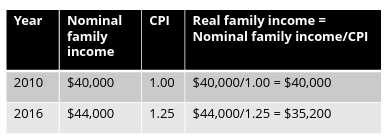
Real vs. Nominal Interest Rates
Real interest rate = nominal interest rate - inflation rate
formula: r ≈ i- π
r = real interest rate
i = nominal (market) interest rate
π = inflation rate
example:
bank pays 5% nominal interest
inflation is 3%
real return = 2%